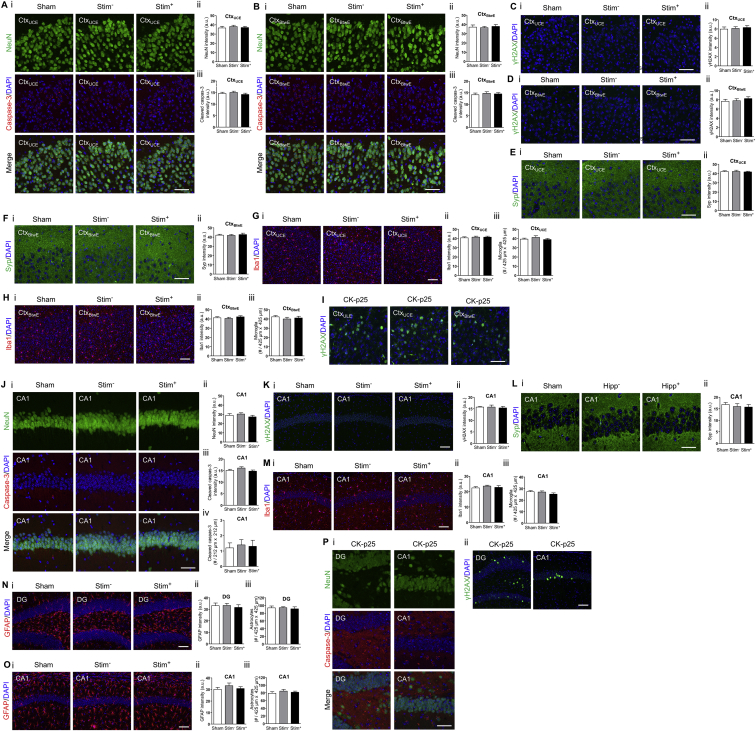Figure S5.
Safety Assessment of Temporal Interference Stimulation, Related to Figure 4
Immunohistochemical measurement of cellular and synaptic markers after TI stimulation (as in Figure 4) of awake mice showing (i) representative immunohistochemically stained slices and (ii-iii) mean ± s.e.m of immunohistochemical values as described below in the individual panel caption sections; Stim+, brain regions from stimulated hemisphere; Stim−, brain regions from the contralateral hemisphere that was not stimulated; Sham, brain regions from mice that underwent the same procedure but with current amplitudes of currents and set to 0 μA. Significance was characterized using one way ANOVA; n = 5 mice, 2 sections from each mouse; scale bars for (i) 50 μm.
(A–I) Cortex.
(A) NeuN staining and cleaved caspase-3 staining for a cortical region underneath the midline (central) electrode (CtxUCE). (ii) NeuN intensity. (iii) Cleaved caspase-3 intensity.
(B) As in (A) but for a cortical region between the electrodes (CtxBtwE).
(C) γH2AX staining for CtxUCE. (ii) γH2AX intensity.
(D) As in (C) but for CtxBtwE.
(E) Synaptophysin (Syp) staining for CtxUCE. (ii) Syp intensity.
(F) As in (E) but for CtxBtwE.
(G) Iba1 staining for CtxUCE. (ii) Iba1 intensity. (iii) Number of Iba1 positive cells.
(H) As in (G) but for CtxBtwE.
(I) γH2AX staining for cortical regions of CK-p25 mouse, an established mouse model of neurodegeneration, with neuronal atrophy, reduced synaptic density and pronounced DNA damage (Cruz et al., 2003, Dobbin et al., 2013, Kim et al., 2008), plotted here as a positive staining control for the utilized antibodies.
(J–P) Hippocampus.
(J) NeuN and cleaved caspase-3 staining for CA1 region of the hippocampus (CA1). (ii) NeuN intensity. (iii) Cleaved caspase-3 intensity. (iv) Number of cleaved caspase-3 cells.
(K) γH2AX staining for CA1. (ii) γH2AX intensity.
(L) Synaptophysin (Syp) staining for CA1. (ii) Syp intensity.
(M) Iba1 staining for CA1. (ii) Iba1 intensity. (iii) Number of Iba1 positive cells.
(N) GFAP staining for dentate gyrus of the hippocampus (DG). (ii) GFAP intensity. (iii) Number of GFAP-positive cells.
(O) As in (N) but for CA1.
(P) Staining for DG and CA1 regions of CK-p25 mouse, an established mouse model of neurodegeneration, with neuronal atrophy, reduced synaptic density and pronounced DNA damage (Cruz et al., 2003, Dobbin et al., 2013, Kim et al., 2008), plotted here as a positive staining control for the utilized antibodies. (i) NeuN and cleaved caspase-3 staining. (ii) γH2AX staining. See Table S3 for full statistics for this figure.

